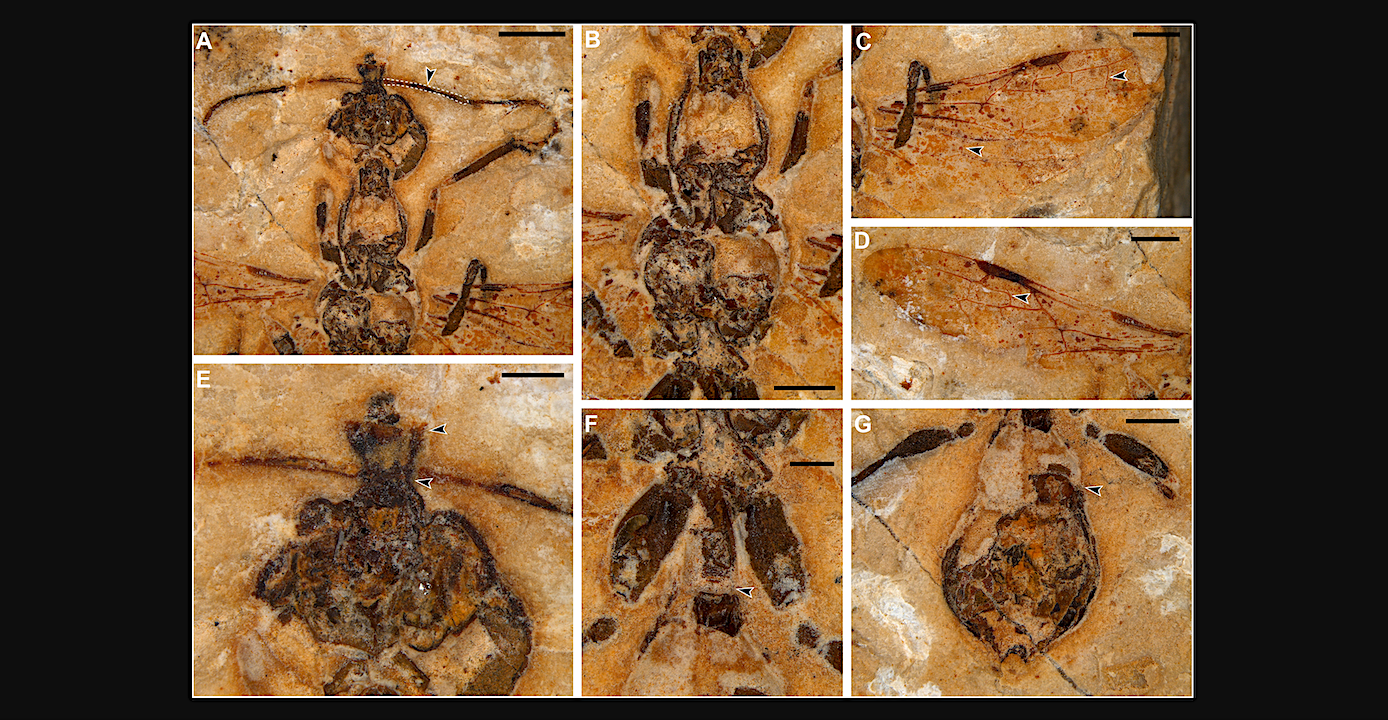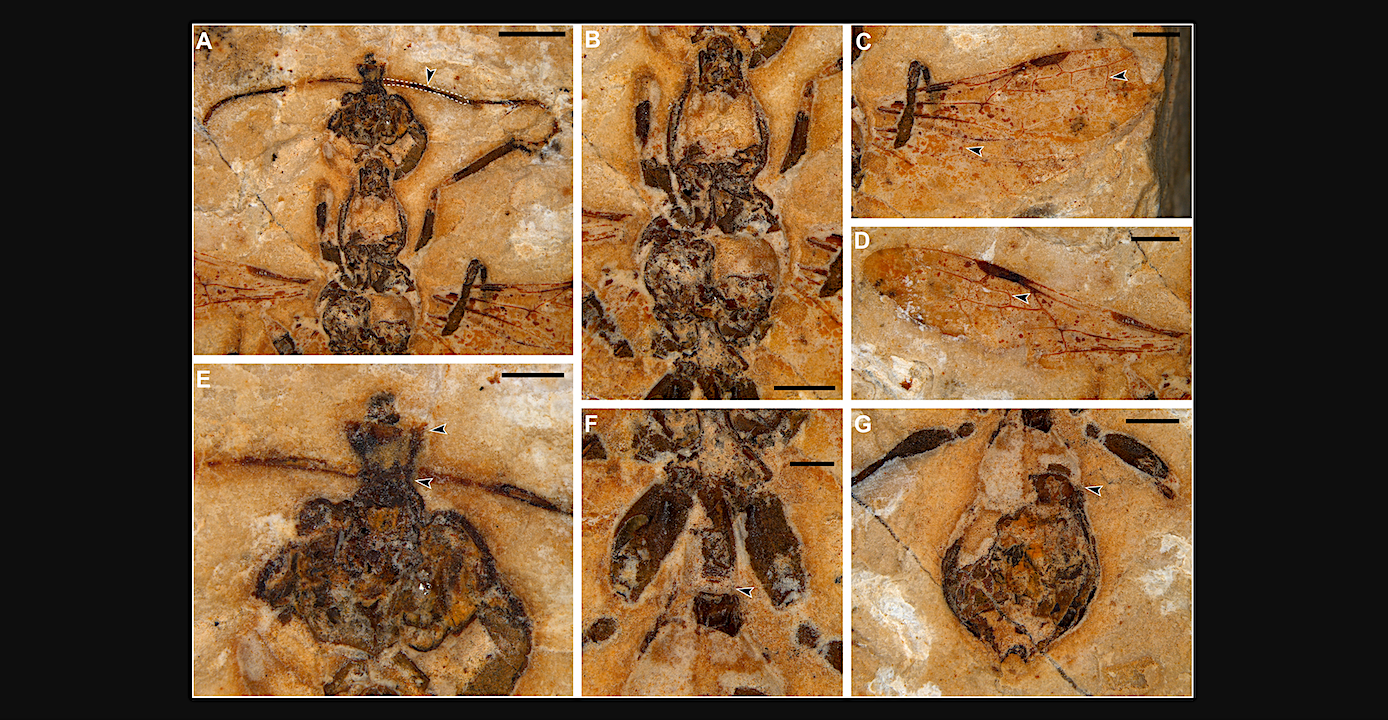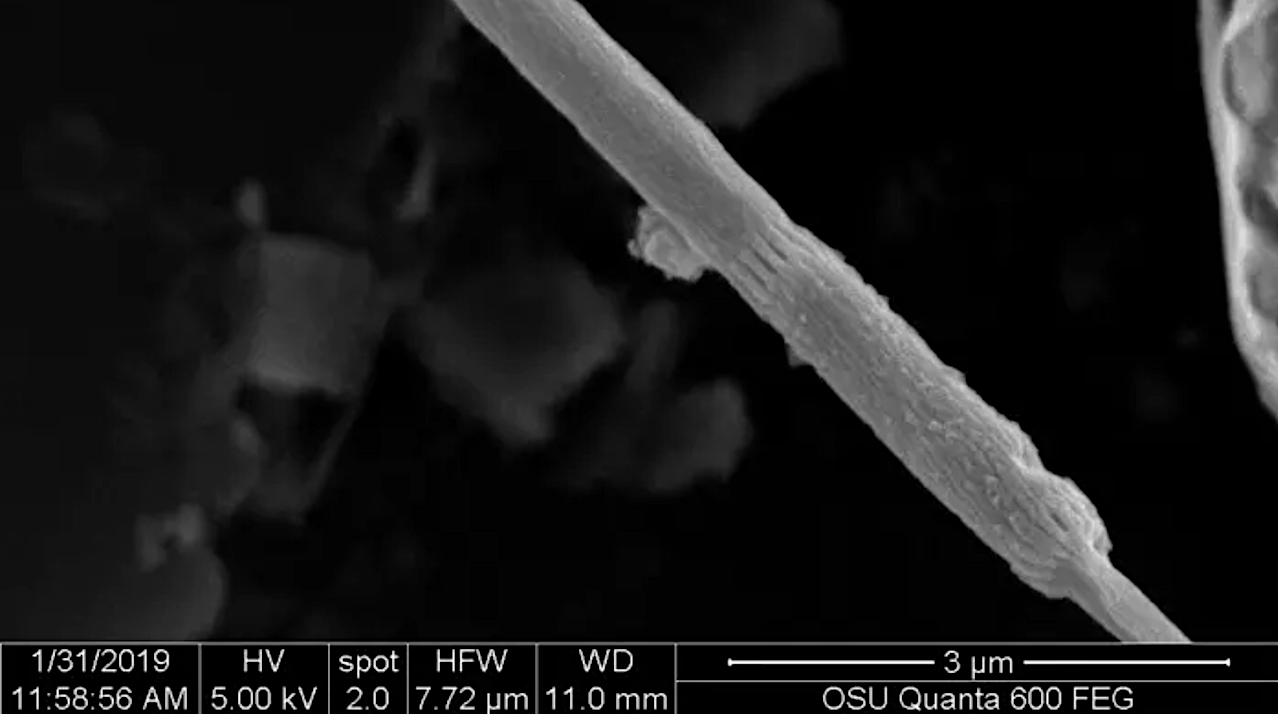Now Reading: Biosignatures: The Oldest Ant Ever Discovered Found Fossilized In Brazil
-
01
Biosignatures: The Oldest Ant Ever Discovered Found Fossilized In Brazil
Biosignatures: The Oldest Ant Ever Discovered Found Fossilized In Brazil


Photographs depicting details of Vulcanidris cratensis gen. et sp. nov. — Current Biology
Holotype (MZSP-CRA-0002).
(A) Head and anterior portion of mesosoma. Scale bar, 1 mm.
(B) Mesosoma. Scale bar, 1 mm.
(C) Left forewing. Scale bar, 1 mm.
(D) Right forewing. Scale bar, 1 mm.
(E) Detail of head. Scale bar, 0.5 mm.
(F) Detail of petiole. Scale bar, 0.5 mm.
(G) Metasoma. Scale bar, 1 mm. Arrowheads indicate key characters mentioned in the text.
Editor’s note: we currently have three rovers on Mars – and other in orbit – searching in one way or another for biosignatures – chemical and/or geological traces that life has left behind – if there ever was (or perhaps still is) life on Mars. Some of these indicators may point to environments wherein life (as we know it) would have found habitable conditions. In some cases life leaves behind fossils- mineralized versions of structures that were once biological. Often times, the fossilization process can preserve organic substances well enough that we can derive information about the organism that once contained them. Proteins, nucleic acid components, and other materials preserved in fossils found on Earth can now provide exquisite indications of a wide range of ancient life’s characteristics. It is not unrealistic to suggest that life on Mars – inhabiting environments similar to those found on Earth – could have left fossils behind. After all, we’ve found microfossils of early life forms billions of years old here on Earth. Earth is an analog for what we might find on Mars.
A 113-million-year-old hell ant that once lived in northeastern Brazil is now the oldest ant specimen known to science, finds a report publishing in the Cell Press journal Current Biology on April 24. The hell ant, which was preserved in limestone, is a member of Haidomyrmecinae—an extinct subfamily that only lived during the Cretaceous period. These ants had highly specialized, scythe-like jaws that they likely used to pin or impale prey.
“Our team has discovered a new fossil ant species representing the earliest undisputable geological record of ants,” said author Anderson Lepeco of Museu de Zoologia da Universidade de São Paulo in Brazil. “What makes this discovery particularly interesting is that it belongs to the extinct ‘hell ant,’ known for their bizarre predatory adaptations. Despite being part of an ancient lineage, this species already displayed highly specialized anatomical features, suggesting unique hunting behaviors.”
The ant fossil’s discovery challenges our understanding of ant evolution and biogeography through time, according to the researchers. The previous oldest ants were found in France and Burma and were preserved in amber instead of limestone. The existence of a hell ant in Brazil shows that ants were already widely distributed and diversified early in their evolution, says the team.
“Even though there have been hell ants described from amber, this was the first time we could visualize this in a rock fossil,” said Lepeco.
Lepeco and his team discovered the “remarkably well-preserved” ant specimen while systematically examining one of the world’s largest collections of fossil insects from the Crato Formation, a deposit renowned for its exceptional fossil preservation. The collection is housed at the Museu de Zoologia da Universidade de São Paulo.
“When I encountered this extraordinary specimen, we immediately recognized its significance, not only as a new species but as potentially the definitive evidence of ants in the Crato Formation,” said Lepeco. “This finding highlights the importance of thorough examination of existing collections—private or in museums—and brings a spotlight to Brazilian paleontology and the underexplored fossil insect fauna of the country.”

Holotype (MZSP-CRA-0002).
(A) Habitus, ventral view (portion enclosed within limestone). Scale bar, 2.5 mm.
(B) Head and anterior portion of prothorax. Scale bar, 0.8 mm.
(C) Oblique view of head and anterior portion of prothorax. Scale bar, 0.75 mm.
(D) Detail of head capsule and mandibles. Scale bar, 0.4 mm.
(E) Meso- and metathorax. Scale bar, 1.5 mm.
(F and G) Detail of ventral portion of metepisternum and petiole from the external (F) and internal (G) views. Scale bars, 0.4 mm.
(H) Part of mesosoma, from the dorsal view (internal portion exposed on limestone), exhibiting soft tissues preserved. Scale bar, 1.5 mm. Arrowheads indicate key characters mentioned in the text. — Curent Biology
Micro-computed tomography imaging—a 3D imaging technique that uses X-rays to view the inside of an object, or ant in this case—showed that the newly discovered ant was closely related to hell ants previously known only from specimens preserved in Burmese amber—a type of amber found in Myanmar. The finding shows that the ants were widely distributed across the globe and must have crossed Cretaceous landmasses repeatedly, say the authors. But what astonished them most was the hell ant’s specialized features.
“While we expected to find hell ant features, we were shocked by the characteristics of its feeding apparatus,” said Lepeco. Unlike modern ants with laterally moving mandibles, this species possessed mandibles that ran forward parallel to the head and facial projection anterior to the eyes, the researchers noted.
“Finding such an anatomically specialized ant from 113 million years ago challenges our assumptions about how quickly these insects developed complex adaptations. The intricate morphology suggests that even these earliest ants had already evolved sophisticated predatory strategies significantly different from their modern counterparts.”
The discovery of this new ant specimen raises broader questions about the evolutionary pressures that led to the hell ant’s unique adaptations, say the researchers. With advanced imaging tools, it’s now possible to examine such fossil specimens in much greater detail than ever before.

A paleoartistic reconstruction of the new species, based on the fossil and on a close relative species found in amber from Myanmar. Credit Diego M. Matielo
A hell ant from the Lower Cretaceous of Brazil, Current Biology (open access)
Astrobiology,
Stay Informed With the Latest & Most Important News
Previous Post
Next Post
-
 012024 in Review: Highlights from NASA in Silicon Valley
012024 in Review: Highlights from NASA in Silicon Valley -
 02Panasonic Leica Summilux DG 15mm f/1.7 ASPH review
02Panasonic Leica Summilux DG 15mm f/1.7 ASPH review -
 03From Polymerization-Enabled Folding and Assembly to Chemical Evolution: Key Processes for Emergence of Functional Polymers in the Origin of Life
03From Polymerization-Enabled Folding and Assembly to Chemical Evolution: Key Processes for Emergence of Functional Polymers in the Origin of Life -
 04How New NASA, India Earth Satellite NISAR Will See Earth
04How New NASA, India Earth Satellite NISAR Will See Earth -
 05And Thus Begins A New Year For Life On Earth
05And Thus Begins A New Year For Life On Earth -
 06Astronomy Activation Ambassadors: A New Era
06Astronomy Activation Ambassadors: A New Era -
07SpaceX launch surge helps set new global launch record in 2024




















